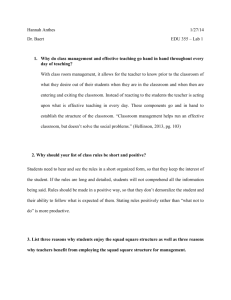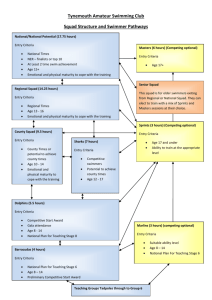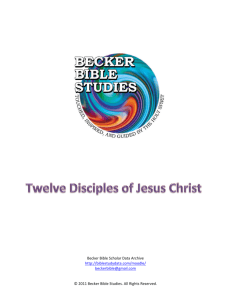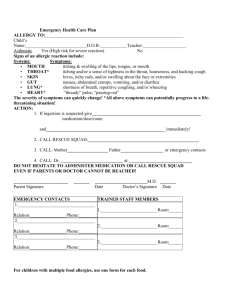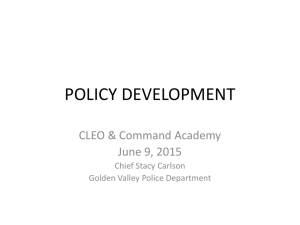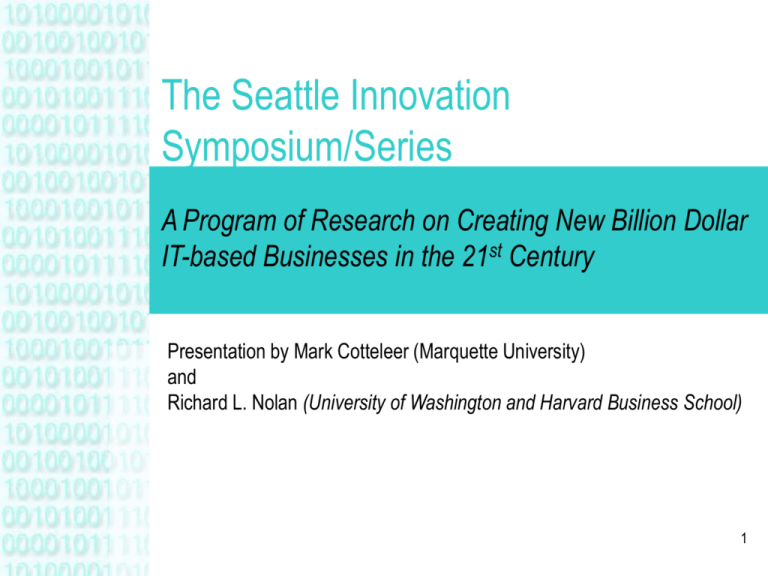
The Seattle Innovation
Symposium/Series
A Program of Research on Creating New Billion Dollar
IT-based Businesses in the 21st Century
Presentation by Mark Cotteleer (Marquette University)
and
Richard L. Nolan (University of Washington and Harvard Business School)
1
Agenda for Today’s Session
A Multi-disciplined University/Enterprise issue
Results of Field Research and Internet2 Ad Hoc
Business Innovation Working Group – Dick Nolan
The Next Step: Broaden the Research Community to
a Multi-disciplined group – The Seattle Innovation
Symposium – Mark Cotteleer
–
–
–
–
What it is
How it will work
When: September 13 and 14, 2004
Contact: seattleinnovation@internet2.edu
2
Nolan/Austin Harvard Business School Internet1
Research 2002
How was Internet1 developed?
How did business almost totally miss it until
1995?
3
Organizational Learning
Stages Theory: Three Eras of IT Growth
Network Era
Micro Era
DP Era
1960
1975
1980
1995
2010
2005
4
Stages Theory: ARPA/Internet
1962 Packet Switching
Organizational Learning
Licklider-MIT
Kleinrock-MIT/UCLA
Baran – Rand
Davies-UK
1966 ARPA
Licklider-MIT
Larry Roberts
1982 TCP/IP
1971 email
Tomlinson- BBN
1973 Internet
Vint Cerf
Bob Kahn
Bob Metcalf
1995 Netscape .com
Andreeson/Clark
1991 WWW
Tim Berns-Lee
1960
DP Era
1980
1995
Micro Era
2005
2010
Network Era
5
J.C.R.Licklider
PhD in 1942, U of
Rochester in Psychology
Bush-”As We May Think”
Atlantic Monthly 1945
Harvard
MIT
Vannevar Bush
Harvard Psych/Accoustic Lab
J.C.R.Licklider-1942
George Miller
Leo Berenek
Stanley Stevens
Licklider- “Man-Machine
Symbiosis” Jan 13, 1960
MIT Accoustics Lab
1949
Licklider
Miller
Berenek
Bolt, Berenek &
Newman
Frank Heart
Dave Walden
Bob Kahn
Ray Tomlinson
Stanford
Stanford Research Inst.
Doug Engelbart
-mouse
-windows
Engelbart – “Augmenting
Human Intellect” 1962
IMP#2
Dec 9, 1968
FJCC
ARPA’s
Woodstock
Englebart
By 1971 ARPA is funding 30
University sites hooked to ARPANET
Rand
Paul BaranPacket-switching
MIT Rad Lab
Natl. Physics Lab-UK
Donald Davies
Packet-switching
Bell Labs
William ShockleyInvented transistor
Lincoln Labs
Wesley Clark
Ivan Sutherland
Larry Roberts
Len Kleinrock
JCR Licklider 10/13/67
Robert Kahn
John McCarthy
Marvin Minsky
SDC
Shockley Transistor
Lab
ARPA-1958
1st Dir-Jack Ruina
1stIPTO Dir-Licklider 1962-64
Ivan Sutherland 1964
Bob Taylor
Larry Roberts
Bob Kahn
Jerry Elkind
Wash U.
Licklider
1964-67
Wes Clark
Fairchild-1957
William Shockley
Gordon Moore
IMP#1
UCLA
Kleinrock
Cerf
Croker
Posh
Licklider’s List:
MIT-timesharing
Carnegie-Simon, Newall, Perlis
Berkeley – timesharing (SDC)
Rand-packet switching
Stanford –AI
SRI-Doug Engelbart
UCLA
CS Grad Meeting
Spon by ARPA
Vint Cerf
U. Illinois
Alan Day
Patrick Winston
John Warnock
Danny Cohen
Bob Blazer
IBM
Carnegie
Simon
Newall
Perlis
Intel-1968
William Shockley
Gordon Moore
Andy Grove
First CS Program 1965
Berkeley
Birthing of the Internet – Decade of the 60’s
IMP#3
U. CA Irvine
U. Utah
Evans
Sutherland
Kay
Bob Taylor
Evans and
Sutherland
Company
Graphics
IMP#4
6
© Richard Nolan and Robert Austin, 2003.
Creating the Networked PC – Decade of the 70’s
By 1971 ARPA is funding 30
University sites hooked to ARPANET
Telenet-1973
JCR Licklider
Marvin Minsky
Larry Roberts
-sub of BBN to
Market private
Packet switching
Harvard
Bob Metcalfe
MIT
Bolt, Branek &
Newman
Frank Heart
Dave Walden
Bob Kahn
Ray Tomlinson
Jerome Elkind
Severo Ornstein
Stanford Research Inst.
Doug Engelbart
Bill English
(+ 12 others)
Lincoln Labs
George Pake Director
Gary Starkweather
Jerry Eklind
Bob Taylor
Gary Starkweather
Severo Ornstein
Alan Kay
Bob Metcalfe
David Boggs
Ed McCreight
Bill English
Charles Geschkle
John Warnock
Dan Ingalls
Butler Lampson
Chuck Thacker
Peter Deusch
Ed Fiala
Richard Shoup
Jim Mitchell
Charles Simonyi
Alto finished in 1973; Star sold
For $18,000 in 1980.
Bob Kahn –1972
1973 paper of Cerf/Kahn
Introduced data grams,
And gateways (TCP)
Larry Roberst leaves
In 1973
In 1975, DCA takes
over management of
ARPANET; BBN
contracts for operation
of ARPANET
BCC
Bulter Lampson
CharlesThacker
Peter Deutsch
Ed Fiala
Richard Shoup
Jim Mitchell
UCAL
Irvine
Berkeley
Dave Evans
Charles Simonyi
IMS-1973
Bill Milliard
Todd Fischer
Xerox
Xerox Parc
U. Utah
Carnegie
Simon
Newall
Perlis
MITS – 1968
Ed Roberts
Paul Allen
Altair 8800
Jan. ‘75 computer
Sold for $397
“Bill Gates”
consultant
Natl. Physics Lab-UK
Licklider replaces
Larry Roberts in
1973 at DARPA
Defense Communication
Agency
U. Illinois
Rand
Paul Baran
Packet switching
MIT Rad Lab
Donald Davies
Packet switching
DARPA
Stanford
John McCarthy
Jim Clark
Hobbiest PC Development
Dave Evans
Sutherland
Alan Kay
Bob Taylor
Developed the
IMSAI 8080
SDC
Wash U.
IMSAI-1976
Bill Milliard
1979 IMSAI
Goes bankrupt
Naval Post
Graduate Sch.
Gary Kildall
Digital Research
1976
Gary Kildall
developed
CP/M
Traf-O-Data –
1972
Bill Gates
Paul Allen
Wes Clark
UCLA
Kleinrock
Cerf
Crocker
Posh
Intel-1968
William Shockley
Gordon Moore
Andy Grove
developed computer
on chip (Intel 4004)
Evans and
Sutherland
Company
Graphics
Computerland
1975
Bill Milliard
Microsoft
1975
Bill Gates
Paul Allen
BASIC
Apple -1976
Steve Jobs
Steve Wozniak
Developed
Apple II-1977
$1300
Tandy -1977
Oracle -1977
Larry Ellison
Ed Cotes
Bob Miner
Oracle Rel DB
Commodore –
1977
PET computer
TRS80 launched
Aug. ’77 sold
For $399
7
© Richard Nolan and Robert Austin, 2003.
Nolan/Austin Internet1 Research
Could it happen again?
Is it happening now?
What can be done?
8
Internet2 AdHoc Business Innovation Group
Marv Adams, Ford Motor
Company
Robert Aiken, Cisco
Jill Arnold, Internet2
Robert Austin, Harvard
Business School
Gary Bachula, Internet2
Mark Cotteleer, Marquette
University
David Croson, Temple
University
Tom DeMarco, Atlantic
Systems Guild
Steve Hall, Thomson
Ted Hanss, Internet2
John Henderson, Boston University
John King, University of Michigan
David Koenig, Citigroup
Alan Murray, Novell
Richard Nolan, Harvard Business
School and University of Washington
Michael Norwich, CS First Boston
Jose Royo, Ascent Media
George Westerman, MIT
Charles Yun, Internet2
Michael Zisman, IBM
Jonathan Zittrain, Harvard Law
School
9
Internet2 AdHoc Business Innovation Group
Deliverable:
– Harvard Business School Working Paper - “On
Identifying and Tracking the Next “Killer App”
Key Conclusions
– Will be a grouping of technologies enabling a new,
important “capability”
– Legacy Industrial age management principles and
practices seriously inhibit emergence of next
business “killer-app”
10
Broadening our Internet2 AdHoc Business
Innovation Group to a Multi-disciplined Network
Austin/Nolan/Lazowska/Eisenberg 2004
The Idea of the Seattle Innovation
Symposium/Series
11
Lessons from the “Tire Tracks Diagram”: The IT
Innovation Ecosystem from earlier research
12
Lessons from the “Tire Tracks Diagram”: The IT
Innovation Ecosystem
Identifies 19 $1 billion (or larger) information
technology-based innovations
Illustrates flows within and between innovations
Identifies (a subset of) innovation contributors
Emphasizes the interrelationships between economic
sectors in the development of major innovation
– University Research (federal funding)
– Industry Research (industry or federal funding)
– Product Introduction $1B markets
13
Shows “Skip-jumping” between innovations
streams is important and not well understood
14
One critical ingredient is always there where there is
high-tech innovation and success: Top universities
Boston: MIT, Harvard
Research Triangle Park: Duke, UNC, NC State
Austin: University of Texas
So. California: UCSD, UCLA, Caltech
No. California: Stanford, Berkeley, UCSF
Puget Sound region: University of Washington
15
Responsible Managers Often Make Rational
Decisions that Impede Innovation.
Established companies
generally don’t capitalize on
innovations
The culprit is good
management (and shareholder
behavior), not bad
management
16
Traditional view
Fundamental
research
Applied
research
17
Concern with use
A more modern, 21st Century view:
Edison
Pasteur; much of
biomedical and
engineering research
Bohr
Concern with science/fundamentals
18
Relevant Research comes from many sources that
coalesce into vibrant networks: Seattle’s Puget Sound
Region
19
What Does This All Mean for today?
Continuing IT innovation will continue to provide
opportunities for firms to raise productivity
Back to the basics – understand and leverage the
role of IT in key business processes/ core
capabilities
Investments in IT capital must be complemented
with corresponding investments in organizational
capital.
20
© 2004 Vijay Gurbaxani, All rights reserved
Who makes innovation happen and emerge into
new billion dollar segments?
Creators (scientist) and Stewards (managers)
21
How hard it is:
Bob Taylor, ARPA, Xerox PARC
“People tell me ‘The Internet happened very fast.’ They’re crazy. It took
forever!”
“[In 1967] I went to Bell Labs and I said, ‘we’re going to have this experimental
interactive network, and I want you guys to be a node on it. I want you to
participate in development of it, so you will know what it’s all about, and you can
embrace it into AT&T when the time comes.’ Bell Labs said, ‘We’re not interested.
Packet switching won’t work.’ Flat out…
“I go to IBM and say ‘I’d like [you] to be a node on this network we’re starting, so
that you can experiment with this technology along with us.’ IBM said, ‘Our
computers can already talk to each other. We’re not interested.’”
“Suppose IBM and AT&T had said ‘You bet’…suppose Xerox in 1975 has...a
successful product focus…AT&T, IBM, and Xerox--three of the strongest, largest,
and most powerful companies of those times, all actively involved in the
development of this technology…we’d have been there a lot sooner.”
22
We think we are smarter than we are: The
Problem of Too-Literal Extrapolation
What will we do with a lot more processing power?
We’ll run out of transactions to process...
– Widespread, but understandable, imaginative shortfall
– Ken Olson (1977): “There is no reason for any individual to
have a computer in their home.
Very difficult to break free of current (1960-70s)
context
– Computers are for complex computations, mundane
transactions
– Processing is a scarce resource, ought to be shared
(timesharing)
23
Actual Trajectory Was Not Obvious
Some did, however, see it
– Vannevar Bush, 1945, “As We May Think” describes hypertext,
http://www.theatlantic.com/unbound/flashbks/computer/bushf.htm
– JCR Licklider, 1960, “Man-Machine Symbiosis,”
http://memex.org/licklider.pdf
– Licklider and Bob Taylor, 1968, “The Computer as a Communication
Device,” http://memex.org/licklider.pdf
– Bob Engelbart, 1968, Fall Joint Computer Conference, Convention
Center in San Francisco
24
Engelbart Demo, December 9, 1968
90-minute live demonstration of an online system
Engelbart and colleagues had worked on since 1962.
Attended by about 1,000 computer professionals.
Public debut of the computer mouse along with
demonstrations of:
Hypertext
Object Addressing
Dynamic File Linking
Shared-screen collaboration involving two persons at
different sites communicating over a network with audio and
video interface.
Streaming video of this demo on line at http://sloan.stanford.edu/mousesite/1968Demo.html 25
The critical role of the creators, but fundamentally,
they “march to a different drummer”
Alan Kay: “The world is run by C-pluses. ARPA aimed at A-plus-plus; no
one asked the A-plus-pluses what they were going to do…Business
would rather control mediocre people than be out of control with
talented people”
Bob Taylor: “We didn’t want to make it commercially viable because we
were good people…I hate business. That’s why I never started a
company…I wouldn’t want to do it for a day…for 35 years, including
now, I never worked with anyone who I didn’t want to work with…the
people I did work with were really good. Lots of IQ points. They weren’t
just good, they were really good.”
Bob Engelbart: “’what if I can maximize the value of my career and help
humankind?’ …you have to have a crusade….
26
Creators and Stewards
Creators
–
–
–
–
Governing impulse: Realize the vision at all costs
Seeks the grand vision, all of it, no compromises
No concept of break-even, does not know or care where it is
Value creator
27
Creators and Stewards
Creators
–
–
–
–
Governing impulse: Realize the vision at all costs
Seeks the grand vision, all of it, no compromises
No concept of break-even, does not know or care where it is
Value creator
Stewards
–
–
–
–
Governing impulse: Law of diminishing returns
Seeks products that are “good enough” but not better
Going beyond break-even is wasteful
Value harvester
28
Stewards and Creators: A History of Discord
[Thorstein Veblen, The Theory of Business Enterprise (1904)]
…
Identifies a powerful conflict...between the engineers and
scientists -- professionals of great skill and productive
potential – and the profit-oriented businessmen.
The businessmen, for good or ill, keep the talents and
tendencies of the scientists and engineers under control and
suppress them as necessary in order to maintain prices and
maximize profits.
From this view of the business firm, in turn, comes an obvious
conclusion: somehow release those who are technically and
imaginatively proficient from the restraints imposed by the
business system and there will be unprecedented productivity
and wealth in the economy.
From J. K. Galbraith’s Economics in Perspective: A Critical History
29
Propositions and Questions for Research
It is difficult to overcome our “present
paradigms”.
– Are there things we can do to shed the limitations
on our vision?
The steward/creator difference in world views
will likely continue
– Are there ways of working that can help us
overcome differences?
30
The Seattle Innovation Symposium
September 13 and 14, 2005
University of Washington Law School – Seattle
100 Research Faculty, PhD Students, & Corporate Researchers
seattleinnovation@internet2.edu
31
The Seattle Innovation Symposium
Objective:
Begin developing a collaborative understanding among
researchers and firms…
seattleinnovation@internet2.edu
about the process of developing important IT
innovations…
leading to a billion dollar product sectors.
32
The Seattle Innovation Symposium
Day 1: Grounding, Lessons Learned from Experience,
and Key Insights
– Plenary Sessions
• IT Innovation Investments, Process, and Results.
• Insights from Internet1 Pioneers: Those that have done it before.
• From Interesting Ideas to Billion Dollar Industries: Those that have
done it recently.
– Moderated Panel Discussions
• Participants form panel, react to plenary speakers
– Preliminary Analytic Framework
seattleinnovation@internet2.edu
33
The Seattle Innovation Symposium
Creators Ask/Answer Questions
(for example)
How can we know where everything is, all the time?
How can we see further/deeper/in greater detail?
How can we structure a question and bring greater
resources to bear on answering it?
seattleinnovation@internet2.edu
34
The Seattle Innovation Symposium
Technology
Attributes
Identification
Location
• Time
• Place
State
• Appearance
• Sound
• Smell
• Feel
• Taste
Connection
• Speed
• Reliability
• Latency
• Ubiquity
• Security
Capabilities
Situational
Awareness
Application
Army
After Next
Resource
Sharing
Grid
Computing
Visualization
Medical
Imaging
35
The Seattle Innovation Symposium
Situational Awareness & “The Army After Next”
– Reducing the Logistics Burden for the Army After Next: Doing More with Less (1999), www.nap.edu
Develop/Deliver Accurate Information
– Friendly & Enemy Locations
– Maps of Local Terrain
– Processed Intelligence
seattleinnovation@internet2.edu
• Opposing Forces
• Weapons
• Activities
36
The Seattle Innovation Symposium
Source: Reducing the Logistics Burden for the Army After Next: Doing More with Less (1999)
Commission on Engineering and Technical Systems (CETS)
37
The Seattle Innovation Symposium
Relevant Enabling Technologies
–
–
–
–
–
–
Electronic and photonic devices
Integrated circuits
Communications Hardware
Information Transmission Algorithms
Software
Complex System and Network Design,
Integration, and Management
Source: Reducing the Logistics Burden for the Army After Next: Doing More with Less (1999)
Commission on Engineering and Technical Systems (CETS)
38
The Seattle Innovation Symposium
Minimize weight and volume of logistical
burden
“Insert a right-size force with the right suite
of weapons and equipment at the right place
and time.”
Source: Reducing the Logistics Burden for the Army After Next: Doing More with Less (1999)
Commission on Engineering and Technical Systems (CETS)
39
The Seattle Innovation Symposium
Technology
Attributes
Identification
Location
• Time
• Place
State
• Appearance
• Sound
• Smell
• Feel
• Taste
Connection
• Speed
• Reliability
• Latency
• Ubiquity
• Security
How do we propose to think about capabilities,
applications, and billion dollar industries?
Capabilities
Situational
Awareness
Application
Army
After Next
Economic Value
Resource
Sharing
Grid
Computing
Recipients?
Visualization
Medical
Imaging
Enablers?
($1 billion industries?)
Potential?
Obstacles?
40
The Seattle Innovation Symposium
Day 2: Searching and Scenario Analysis
“The most remarkable technological innovations occur when small
teams of people are free to explore the outer limits of their
imaginations”
– Eric Schmidt, Chairman and CEO, Google, in Artful Making, 2004.
seattleinnovation@internet2.edu
41
The Seattle Innovation Symposium
Day 2: Searching and Scenario Analysis
– 100 Participants
• Divided into five teams (20 participants each)
– Divided into five squads (four participants each)
Team A
(20)
Team B
(20)
Participant
Pool
seattleinnovation@internet2.edu
Team C
(20)
(100)
Team D
(20)
Team E
(20)
Squad 1
Squad 4
Squad 3
Squad 2
4 per squad
Squad 6
Squad 5
Squad 9
Squad 8
Squad 7
4 per squad
Squad 11
Squad 10
Squad 14
Squad 13
Squad 12
4 per squad
Squad 16
Squad 15
Squad 19
Squad 18
Squad 17
4 per squad
Squad 21
Squad 20
Squad 24
Squad 23
Squad 22
4 per squad
Squad 25
42
The Seattle Innovation Symposium
Day 2: Searching and Scenario Analysis
– Squads Analyze Attributes and Capabilities
– Teams Synthesize and Conceptualize Business
Applications
– Symposium cross-pollinates teams’ efforts
Squad 1
Squad 4
Squad 3
Squad 2
Squad 5
Squad 6
Squad 9
Squad 8
Squad 7
Squad 10
Squad 11
Squad 14
Squad 13
Squad 12
Squad 15
Squad 16
Squad 19
Squad 18
Squad 17
Squad 20
Squad 21
Squad 24
Squad 23
Squad 22
Squad 25
Squads analyze capabilities for business applicability.
seattleinnovation@internet2.edu
43
The Seattle Innovation Symposium
Day 2: Searching and Scenario Analysis
– Squads Analyze Attributes and Capabilities
– Teams Synthesize and Conceptualize Business
Applications
– Symposium cross-pollinates teams’ efforts
Squad 1
Squad 4
Squad 3
Squad 2
Team A
Squad 5
Squad 6
Squad 9
Squad 8
Squad 7
Team B
Squad 10
Squad 11
Squad 14
Squad 13
Squad 12
Team C
Squad 15
Squad 16
Squad 19
Squad 18
Squad 17
Team D
Squad 20
Squad 21
Squad 24
Squad 23
Squad 22
Team E
Squad 25
Teams debrief, synthesize, and integrate squad findings.
seattleinnovation@internet2.edu
44
The Seattle Innovation Symposium
Day 2: Searching and Scenario Analysis
– Squads Analyze Attributes and Capabilities
– Teams Synthesize and Conceptualize Business
Applications
– Symposium cross-pollinates teams’ efforts
Squad 1
Squad 4
Squad 3
Squad 2
Team A
Squad 5
Squad 6
Squad 9
Squad 8
Squad 7
Team B
Squad 10
Squad 11
Squad 14
Squad 13
Squad 12
Team C
Symposium
Convocation
Squad 15
Squad 16
Squad 19
Squad 18
Squad 17
Team D
Squad 20
Squad 21
Squad 24
Squad 23
Squad 22
Team E
Squad 25
Conference convocation hears, synthesizes team reports.
seattleinnovation@internet2.edu
45
The Seattle Innovation Symposium
Day 2: Searching and Scenario Analysis
– Squads Analyze Attributes and Capabilities
– Teams Synthesize and Conceptualize Business
Applications
– Symposium cross-pollinates teams’ efforts
Squad 1
Squad 4
Squad 3
Squad 2
Team A
Team A
Team B
Team B
Squad 5
Squad 6
Squad 9
Squad 8
Squad 7
Squad 10
Squad 11
Squad 14
Squad 13
Squad 12
Team C
Symposium
Convocation
Team C
Squad 15
Squad 16
Squad 19
Squad 18
Squad 17
Team D
Team D
Team E
Team E
Squad 20
Squad 21
Squad 24
Squad 23
Squad 22
seattleinnovation@internet2.edu
Squad 25
Teams select business application targets.
46
The Seattle Innovation Symposium
Day 2: Searching and Scenario Analysis
– Squads Analyze Attributes and Capabilities
– Teams Synthesize and Conceptualize Business
Applications
– Symposium cross-pollinates teams’ efforts
Squad 1
Squad 1
Squad 4
Squad 3
Squad 2
Squad 5
Squad 6
Squad 9
Team A
Team A
Team B
Team B
Squad 4
Squad 3
Squad 2
Squad 5
Squad 6
Squad 8
Squad 7
Squad 10
Squad 11
Squad 14
Squad 13
Squad 12
Squad 15
Squad 16
Squad 19
Team C
Symposium
Convocation
Squad 9
Squad 8
Squad 7
Squad 10
Squad 11
Team C
Squad 14
Squad 13
Squad 12
Squad 15
Squad 16
Squad 18
Squad 17
Squad 20
Squad 21
Squad 24
Team D
Team D
Team E
Team E
Squad 19
Squad 18
Squad 17
Squad 20
Squad 21
Squad 23
Squad 22
Squad 24
Squad 23
Squad 22
Squad 25
Squad 25
Squads analyze (SWOT) specific business application.
seattleinnovation@internet2.edu
47
The Seattle Innovation Symposium
Day 2: Searching and Scenario Analysis
– Squads Analyze Attributes and Capabilities
– Teams Synthesize and Conceptualize Business
Applications
– Symposium cross-pollinates teams’ efforts
Squad 1
Squad 1
Squad 4
Squad 3
Squad 2
Squad 5
Squad 6
Squad 9
Team A
Team A
Team B
Team B
Squad 4
Squad 2
Squad 5
Squad 6
Squad 8
Squad 7
Squad 10
Squad 11
Squad 14
Squad 13
Squad 12
Squad 15
Squad 16
Squad 19
Team C
Symposium
Convocation
Squad 9
Squad 7
Squad 10
Squad 14
Squad 18
Squad 17
Squad 20
Squad 21
Squad 24
Team D
Team E
Team E
Squad 12
Squad 15
Squad 19
Squad 22
Team D
Squad 18
Squad 17
Squad 20
Squad 21
Squad 23
Team C
Squad 13
Squad 16
Team D
Team B
Squad 8
Squad 11
Team C
Team A
Squad 3
Squad 24
Team E
Squad 23
Squad 22
Squad 25
Squad 25
Teams debrief, synthesize, and integrate squad findings.
seattleinnovation@internet2.edu
48
The Seattle Innovation Symposium
Day 2: Searching and Scenario Analysis
– Squads Analyze Attributes and Capabilities
– Teams Synthesize and Conceptualize Business
Applications
– Symposium cross-pollinates teams’ efforts
Squad 1
Squad 1
Squad 4
Squad 3
Squad 2
Squad 5
Squad 6
Squad 9
Team A
Team A
Team B
Team B
Squad 4
Squad 2
Squad 5
Squad 6
Squad 8
Squad 7
Squad 10
Squad 11
Squad 14
Squad 13
Squad 12
Squad 15
Squad 16
Squad 19
Team C
Symposium
Convocation
Squad 9
Squad 7
Squad 10
Squad 14
Squad 18
Squad 17
Squad 20
Squad 21
Squad 24
Team D
Team E
Team E
Squad 12
Squad 15
Squad 17
Squad 22
Team D
Squad 20
Squad 24
Team E
Squad 23
Squad 22
Symposium
Convocation
Squad 19
Squad 18
Squad 21
Squad 23
Team C
Squad 13
Squad 16
Team D
Team B
Squad 8
Squad 11
Team C
Team A
Squad 3
Squad 25
Squad 25
Conference convocation hears, synthesizes team reports.
seattleinnovation@internet2.edu
49
The Seattle Innovation Symposium
Day 2: Searching and Scenario Analysis
– Squads Analyze Attributes and Capabilities
– Teams Synthesize and Conceptualize Business
Applications
– Symposium cross-pollinates teams’ efforts
Squad 1
Squad 1
Squad 4
Squad 3
Squad 2
Squad 5
Squad 6
Squad 9
Team A
Team A
Team B
Team B
Squad 4
Squad 2
Squad 5
Squad 6
Squad 8
Squad 7
Squad 10
Squad 11
Squad 14
Squad 13
Squad 12
Squad 15
Squad 16
Squad 19
Team C
Symposium
Convocation
Squad 9
Squad 7
Squad 10
Squad 14
Squad 18
Squad 17
Squad 20
Squad 21
Squad 24
Team D
Team E
Team E
Squad 12
Squad 15
Squad 17
Squad 22
Team D
Squad 20
Squad 24
Team E
Squad 23
Squad 22
Symposium
Convocation
Squad 19
Squad 18
Squad 21
Squad 23
Team C
Squad 13
Squad 16
Team D
Team B
Squad 8
Squad 11
Team C
Team A
Squad 3
Squad 25
Squad 25
Doctoral Student Consortium Develops Proceedings Plan and
Preliminary Research Agenda.
seattleinnovation@internet2.edu
50
The Seattle Innovation Symposium
Where do we go from here?
– Identifying Participant Candidates
– Confirm Participation
– Assemble in Seattle in September
Nominate Candidates (faculty, doctoral students, firms)
– Email:
seattleinnovation@internet2.edu
51

